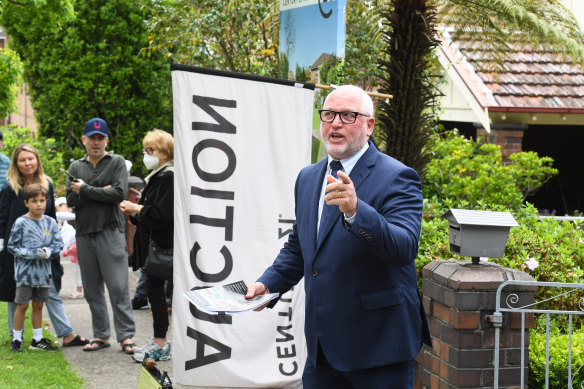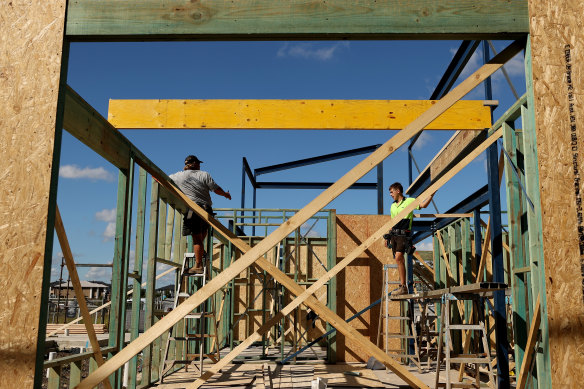This was published 2 years ago
Property prices to fall up to 20 per cent: RBA
By Shane Wright
Property prices could fall as much as 20 per cent by the end of 2024, hitting consumers and wiping hundreds of billions of dollars worth of wealth from households, internal research by the Reserve Bank has found.
Documents released under Freedom of Information by the bank show it believes the sharp rise in interest rates it has put in place to quell inflation will have a direct impact on the value of the largest asset held by most Australians over the next two years.

Internal Reserve Bank documents show housing prices could fall by up to 20 per cent, depending on how people react to higher interest rates.Credit: Peter Rae
In one document, an RBA economist says the fall in inflation-adjusted terms could be the largest to hit the Australian property market since the early 1980s.
The bank has increased interest rates at its past six meetings, taking the official cash rate from 0.1 per cent in early May to 2.6 per cent. It is expected to lift rates at its last two meetings of the year, leaving the cash rate at 3.1 per cent before Christmas.
House prices, particularly in Sydney and Melbourne, were falling even before the RBA started lifting rates. Sydney prices, as measured by Corelogic, are down 9 per cent since their January peak while Melbourne prices have fallen 5.6 per cent since February.
But the Reserve Bank internal documents, many of which date from August when the RBA lifted rates by a half percentage point, show growing uncertainty about how far prices will fall and the macroeconomic impact of that decline.
The documents show the bank expects prices to fall nationally by 11 per cent by the middle of next year before stabilising. Prices in Sydney and Melbourne are likely to fall by 1.5 per cent a month through the rest of 2022.
The national fall could be even larger, at 20 per cent by the end of 2024, depending on how people respond to both the drop in prices and to even higher interest rates.
The RBA economist quoted in the papers said prices would likely continue to fall.
“We’re now anticipating housing prices to decline over the next few years. That reflects the ongoing slowing in momentum in the market and the steepening of expectations for the future path of interest rates,” they said.
The bank has lifted interest rates to put downward pressure on inflation. Figures from the Australian Bureau of Statistics on Wednesday are expected to show the annual inflation rate above 7 per cent for the first time since 1990.
At the weekend, the auction clearance rate was steady at 62 per cent in Sydney and 64 per cent in Melbourne. In both cities, however, large numbers of properties were either withdrawn from auction or passed in.
Household consumption is the largest part of the national economy, accounting for more than 60 per cent of GDP.
The internal documents show the bank knows household spending is likely to edge down as house prices fall. The drop in prices will also hit household wealth, which peaked at almost $15 trillion in March but fell by $484 billion in the June quarter.
“Larger than expected falls in housing prices and hence household wealth would pose a downside risk to consumption,” it said.

Falling house prices would contribute to a rise in home construction business insolvencies, Reserve Bank documents suggest.Credit: Bloomberg
The documents also show the bank expects capacity constraints, which have hit the housing construction sector, to continue at least into the middle of next year. There is a growing risk higher interest rates will also drive more builders to the wall.
“Binding capacity constraints, which are expected to last until mid-2023, are now expected to limit the rate of growth and the level of dwelling investment,” one document noted.
“Strong growth in labour and materials costs are expected to compress margins and increase the risk of insolvencies.”
The RBA forecast of up to a 20 per cent fall brings it into line with most of the major banks.
NAB is tipping a 17.9 per cent fall across all capital cities from the peak of the market to its bottom, with larger falls of almost 22 per cent in both Sydney and Melbourne.
Canstar finance commentator Steve Mickenbecker said predictions of steep price falls would weigh on the market, particularly among first-time buyers who may hold out waiting for a cheaper property.
“A move to buy too soon will see first home buyers’ equity plummet alarmingly and leave them with a large debt. Conversely being conservative may see them miss out if price projections have been too alarmist,” he said.
Cut through the noise of federal politics with news, views and expert analysis from Jacqueline Maley. Subscribers can sign up to our weekly Inside Politics newsletter here.